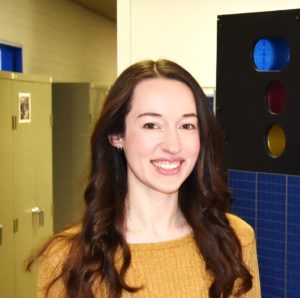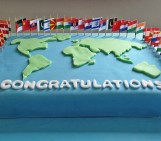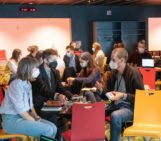

Noel Baker, Climate scientist, project manager, EGU’s Science for Policy Working Group member, and artist
Communicating with the public and policymakers enables scientists to share their passion with those outside of their field and create greater impact. Often when scientists consider engaging non-experts, they imagine public lectures or blog posts, but finding more creative ways to communicate scientific information can be both rewarding and incredibly effective. This month’s GeoPolicy Blog post is authored by Noel Baker, climate scientist and project manager at the Royal Belgian Institute for Space Aeronomy, member of EGU’s Science for Policy Working Group, and artist. In this post, Baker highlights the “Seas and Oceans” art expo and cultural event that features many exciting activities, including the display of a series of artworks produced through collaborations between scientists and artists. Baker explains her motivations to engage in #SciArt, its ability to impact a wide range of different stakeholders, and how other scientists can get involved!
Like many scientists, I joined academia out of a strong desire to bring a meaningful, positive impact on the world through my career. It’s this passion and drive that inspires us to push the boundaries of knowledge, to discover and grow, and to communicate our exciting discoveries to others. That communication is perhaps the most critical step of the scientific process, because it is only by telling others about what we’ve learned that we can have a meaningful impact. Much of our communication, unfortunately, stays between experts in our particular fields – or when it is published, it’s often in the form of highly technical articles and reports – making it inaccessible to the public. Most people never learn of our discoveries, and thus aren’t able to share in the excitement and passion we feel for our research.
Opportunities to communicate with non-experts provide a means to share that passion with others outside our field; outreach, though, is not a simple task. We don’t (typically) receive formal training during our schooling and education in the proper ways to give scientific presentations — for example, the fundamentals of data visualisation and graphic design for creating effective posters to efficiently communicate results — let alone training on how to “translate” complex scientific concepts and jargon into language that the average person can understand. Indeed, those of us who are interested in outreach have generally needed to educate ourselves on the fundamentals, whether by seeking out training resources or through painful trial-and-error. Most of us know the feeling of trying to explain our expertise to someone and seeing only a confused or disinterested face. These experiences can be frustrating for everyone, becoming barriers that may discourage scientists from doing outreach activities. But despite the challenges, outreach and communication can be incredibly rewarding for both scientists and their audience. What we often find when communicating with the public and policymakers is that the information itself is not always received or remembered, but the passion and excitement absolutely is. We love what we do, and sharing that love is what drives us to communicate. Hearing feedback from people who have been inspired by us is tremendously fulfilling, and it provides immediate evidence that our research is having a positive impact on the world.

The Transformative Power of Art. Credit: Talk CEC
One means of communicating science effectively, whether that be to policymakers or the general public, is to translate it into a form that is accessible to everyone. Art is one such form: something that both provides an effective visualisation of ideas and a clear communication with the audience by evoking emotion, two areas which are often challenges in science. The strength of an art/science synergy is twofold. Art itself is an incredibly effective communication tool that can influence our perception of the world, and even increase our awareness of it. Art has often been presented as the reflection of an era: of the issues that define it and the values of the people who live through it. And it provides an undeniably strong means of conjuring emotion, one of the most effective ways to effect change and influence. Science, on the other hand, is our tool for understanding the universe, for pushing the limits of our knowledge, for making discoveries and exploring. Both science and art are driven by passion and innovation, and each can be inspired by the other, making art and science both fantastic means of outreach.

Noel Baker, Climate scientist, project manager, EGU’s Science for Policy Working Group member, and artist
For those of us who seek to engage with the public or policymakers but don’t yet have much experience with it, or for those who have done outreach before but would be interested in doing it in a unique, extraordinary way, I am pleased to share an upcoming opportunity. Talk C.E.C. — an art gallery and cultural nexus in Brussels — is currently seeking scientists who would like to participate in an upcoming immersive art/science experience. This two-month event will take place next year from April 20 – June 25, and it will feature a fantastic schedule of activities including: a “Seas and Oceans” themed immersive & interactive art exhibition of ~40 international artists, themed conferences by scientists and experts, educational workshops with local schools, collaborations between artists and scientists for science-inspired artworks & data visualization, a “Science Café” for informal chats between experts and the public with food and drinks, live art and music performances and networking “afterwork” drinks!
The intention of the event, first and foremost, is to provide a deeply inspiring and enjoyable experience for the public through an energised dialogue about important environmental topics and scientific concepts. Everyone involved in bringing this event to life — the Talk C.E.C. organisation, the artists, and the scientist participants — are passionate about environmental/societal issues and strongly interested in connecting and communicating, bringing a high level of motivation and energy into this event.
If you are a scientist or expert in a geoscience field and would be interested in getting involved, there are many ways you can participate, either in-person in Brussels or through virtual collaboration:
- Pairing with an artist to collaborate on an artwork inspired by your research,
- Giving a talk to the public,
- Holding a conference while an artist performs a live painting,
- Participating in the Science Café informal chats,
- Participating in the afterwork networking, and more.
You can read more about the event, the artists involved, and how you can engage with it as a scientist, here. Keep in mind that while the scientist/artist artwork collaborations will relate to the main expo theme (seas and oceans), your topic of expertise can be a different field! Feel free to contact us to discuss possible topics, or for any other questions. Please note that the deadline to participate in the scientist/artist collaborations is in November, and the deadline to register for participating in the other activities is 15 January 2023.
I look forward to meeting you one day in Brussels!




Np
Your art , science and inspiration will help save our oceans.